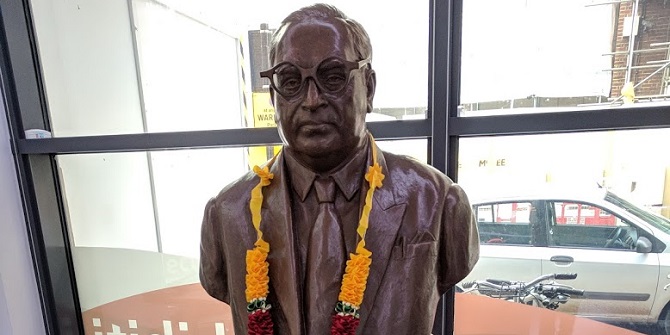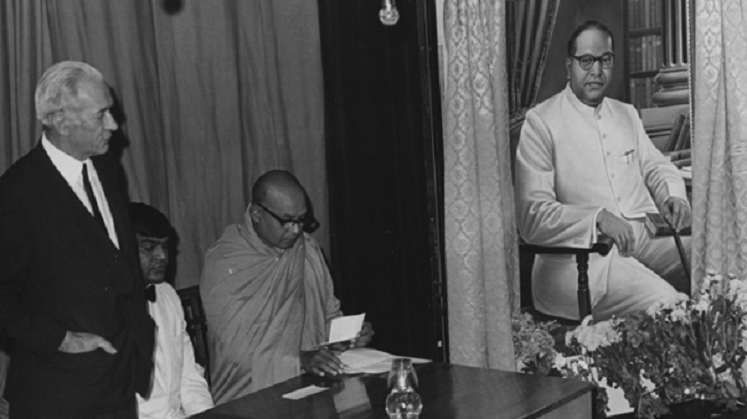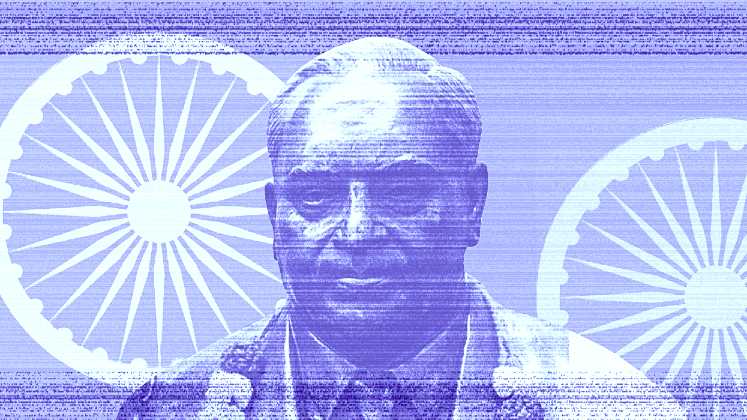Sonali Campion looks back on the life of B R Ambedkar, the leading jurist and social reformer. She considers how his education in India and abroad, as well as his lifelong campaign to advance the rights of minorities, meant he was uniquely qualified to lead the process of crafting of the Indian Constitution after independence.
Bhimrao Ramji Ambedkar is perhaps best known as the principle architect of the Indian Constitution and a staunch champion of Dalit rights (or “Untouchables” as they were referred to in colonial India). He played a key role in the discussions leading up to independence, for example as one of the two Untouchable delegates chosen by the British to attend the Round Table conferences on India’s constitutional status in the early 1930s. He also served as the first Minister of Law and Justice in post-colonial India between 1947 and 1951.
B R Ambedkar was born on 14 April 1891 into an Untouchable caste, known as Mahar – a group which was viewed by the British as “inferior village servants”. He experienced discrimination from an early age, which he described vividly in his later writing, Waiting for a Visa, c1936:
While in the school I knew that children of the touchable classes, when they felt thirsty, could go out to the water tap, open it, and quench their thirst…But my position was separate. I could not touch the tap; and unless it was opened for it by a touchable person, it was not possible for me to quench my thirst.
Despite his lowly caste, Ambedkar’s father had become an officer in the Indian Army and was able to insist that his sons should be educated so Ambedkar was allowed to attend school. At that time teachers were often reluctant to engage with Dalit children, often refusing to mark their exams. Ambedkar was the first in his community to graduate High School and went on to study for a BA in Economics and Politics at Bombay University, where he met Sayaji Rao III, the Maharajah of the princely state of Baroda. The Maharajah was an active advocate of social reforms, including the removal of untouchability. He sponsored Ambedkar’s further education abroad, first at Columbia University in New York where he completed a Masters and a PhD, and later at LSE. During this period Ambedkar studied economics, history and political science, and wrote on a wide range of topics, including the history of caste in India. There is also evidence in his letters at this time of his belief in education as a path to progress, with a particular emphasis on female education.
In 1917 Ambedkar’s studies were disrupted by the war and the termination of his scholarship. He was obliged to return to India, where he was forcibly reminded of his Untouchable status, something which he had been able to escape while studying in the West. Even when he was appointed as a Professor at the Sydenham College of Commerce and Economics in Bombay, other faculty would object to him using the communal water jug. It was at this time that he began to campaign in earnest for Dalit rights. In 1919 he gave evidence to the British in favour of separate electorates and reserved seats for Untouchables and religious minorities, ahead of the Government of India Act 1919 which laid the first (very limited) foundations for Indian self-government. In 1920 he started a weekly Marathi paper, which strongly criticised the caste hierarchy and called for a Dalit awakening and mobilisation against inequality. He also spoke at two Conferences of the Depressed Classes convened by the Maharajah of Kolhapur, both of which culminated in powerfully symbolic inter-caste dining. It was with the financial support of the Maharajah of Kolhapur that he was then able to return to London and complete his studies at LSE, and his legal training at Gray’s Inn.
On his return to Bombay in 1924, Ambedkar intensified his campaign for social reform by establishing the Bahishkrit Hitakarini Sabha (Group for the Wellbeing of the Excluded) to promote socio-political awareness among the Dalits and raise public awareness of their grievances. Over the next twenty years, he played a key role in organising the Untouchables. He created Dalit newspapers, social and cultural institutions, attended more conferences of the Depressed Classes, initiated protests against discrimination in temple entry and access to water, and passionately promoted Dalit access to education. At the same time, he took opportunities offered by the British government to petition for political rights, even on occasions when the Indian National Congress chose to boycott the constitutional reform discussions, for example during the Simon Commission. He also founded two political parties to contest elections that were granted by the British in 1937 and 1946, although these had little success against the well-resourced Congress Party.
Although he was critical of British colonial government, Ambedkar was often at odds with Congress and the nationalist movement, predominantly because they clashed over how to address the issue of Untouchability. In 1932 British Prime Minister Ramsay Macdonald granted the Communal Award to provide for separate electorates for minorities, including Untouchables. But Gandhi was adamant that he could not accept such a split in the Hindu vote and began a fast until death, forcing Ambedkar to backtrack and agree to joint electorates. Throughout the 1930s the relationship between the two became increasingly fractious: Ambedkar saw Gandhi’s attempt to persuade Hindus to reform, rather than reject, the caste system as ineffectual and a barrier to Dalit political rights. In the late 1930s Gandhi and Ambedkar exchanged terse correspondence highlighting their differences (see, for example, Appendix I and II of The Annihilation of Caste), and in the 1940s Ambedkar penned two texts criticising Congress and Gandhi and charging them with gross hypocrisy.
Despite Ambedkar’s differences with Congress, when India became independent in August 1947, Prime Minister Nehru invited him to be the first Minister of Law and Justice. Shortly after, the Constituent Assembly appointed Ambedkar as Chair of the Drafting Committee for the new Constitution. Although specialised sub-committees drafted the primary texts, Ambedkar’s position meant he played a vital role in editing and clarifying the content (particularly as the other members of Drafting Committee were absent for most of the process). Christophe Jaffrelot, in his book Dr Ambedkar and the Untouchables, highlights Ambedkar’s commitment and close attention to detail: not only would he edit the articles, he would also attend the Constituent Assembly debates to defend certain formulations and to guide the discussion (pp.107-8). Ambedkar’s influence can be seen in many aspects of the resulting Indian Constitution such as the strong emphasis on liberal democracy, the federal structure, and the provisions and safeguards for minorities alongside the emphatic abolition of Untouchability.
The Constitution was promulgated on 26 January 1950. Ambedkar appreciated that it had its limitations and declared that political democracy could have no meaning without social democracy. Indeed, it was the refusal of Congress to agree to a uniform civil code that would have been socially progressive, for example in advancing gender equality, but would have restricted the ability of Hindus and Muslims to practice personal religious laws, that led Ambedkar to resign from his position as Minister of Law and Justice in 1951.
However, he remained confident that the new Constitution represented a solid foundation for India to build from as a new independent nation. cf D Keer Dr Ambedkar: Life and Mission p410:
I feel that the Constitution is workable; it is flexible and it is strong enough to hold the country together both in peace time and in war time. Indeed, if I may say so, if things go wrong under the new Constitution the reason will not be that we had a bad Constitution. What we will have to say is that Man was vile.
Dr Ambedkar died in Delhi in 1956.
This article originally appeared on the South Asia @ LSE blog
To find out about LSE’s South Asia collections head to the LSE Library’s Traces of South Asia webpage.







nice
It is great that, Ambedkar’s scholarship is increasing in Western University. This article is portraying Ambedkar Educational biography also his struggle. I have looked Ambedkar not as a social reformer which Dhanajay Keer has regarded him, which has created great misconception in academia. One need to re-articulate, Ambedkar biography and struggle. Ambedkar cannot be fit with the category of social reformer. If one seriously engage and study Ambedkar entire writing and activism. He is a Revolutionary, radical democrat with par excellence.
Salute as Man like Dr Bhimrao Ambedkar who battles a real existence trouble. I am exceptionally enlivened from him… Thanks for sharing
We’are proud of you sir. You did an amazing job for the people of India. Salute to you.
It’s great that in Western University, Ambedkar’s scholarship is growing. This article describes his struggle as well as Ambedkar Educational Biography. I did not see Ambedkar as a social reformer considered by Dhanajay Keer, who created great misunderstanding in academia. One must re-articulate thebiography and struggle of Ambedkar. Ambedkar can’t fit the social reformer category. If one is seriously engaging and studying all of Ambedkar’s writing and activism. He’s a par excellence revolutionary, radical democrat.
Salute as Man like Dr Bhimrao Ambedkar who struggles a life difficulty. I am very inspired from him… Thanks for sharing
This article on Ambedkar gives us a good insight into his life and education. His contribution for Indian Constitution is really a great effort. Bringing the downtrodden Dalits to some high positions these days is a reality because of this great man. It really leaves an impeccable impression on this man. Hats off to Ambedkar sir.
Absolute legend. I highly appreciate this website as all information is very helpful and correct. thanks for sharing such an amazing article. Ambedkar sir remains the greatest forever.
We’are proud of you sir. You did an amazing job for the people of India. Salute to you.
We’ are proud of you sir. You did an amazing job for the people of India. Salute to you.
It is incredible that, Ambedkar’s grant is expanding in Western University. This article is depicting Ambedkar Educational life story additionally his battle. I have looked Ambedkar not as a social reformer which Dhanajay Keer has respected him, which has made extraordinary misguided judgment in the scholarly world. One have to re-articulate, Ambedkar life story and battle. Ambedkar can’t be fit with the class of social reformer. On the off chance that one truly draw in and study Ambedkar whole composition and activism. He is a Revolutionary, radical democrat with second to none.
Salute as Man like Dr Bhimrao Ambedkar who battles a real existence trouble. I am exceptionally enlivened from him… Thanks for sharing
It is great that, Ambedkar’s scholarship is increasing in Western University. This article is portraying Ambedkar Educational biography also his struggle.
Thanks for sharing DR. Bhim Rao ambedkar biography, he was really a great man.
We miss him.
He was the Legend of the poor and Untouchability people…….. Jai Bhim to all ………………
Thanks, for sharing this valuable article with us.
I am so glad to read more about sir B.R ambedkar.
According to me everyone might be interested to read this post.
B.R ambedkar sir we miss you a lot.
Thanks for Sharing such a available information about a legend that always gonna be in our hearts.
Starsunleash
I am proud of dr. B Ambedkar ❤
The biography of Dr Bhim Rao Ambedkar really inspire us..he had done such a great work for nation..thanks for writing this..
The biography of this great man is really inspirational….he has lots of contribution in building our nation
Really helpful i came to know a lot more about Dr. B.R Ambedkar.
Amazing information
A lot of thanks for sharing this article. Great people make the great history.
Amazing post thanks
Nice article …it was veryhelpfull..thanx
Very nice and amazing knowledge thanku for sharing your knowledge
Very informative and useful content thanku for sharing your knowledge
This article on Ambedkar gives us a good insight into his life and education. His contribution for Indian Constitution is really a great effort. Bringing the downtrodden Dalits to some high positions these days is a reality because of this great man. It really leaves an impeccable impression on this man. Hats off to Ambedkar sir.
Good article
Great article of great person. Good Job
Hey…
Useful knowledge.
thanks for the great information
Sir you have given very good information which has helped meComment meaning in hindi
That’s a great article! This neatly organized content is good to see and I’m very impressed.
“Life should be great rather than long”.
Great article of great person
These Quotes by Dr. B R Ambedkar had changed my life in a postive diection. Here are the quotes : –
I measure the progress of a community by the degree of progress which women have achieved.”
“Freedom of mind is the real freedom.
One whose mind is not free though alive, is no better than dead.
All these quotes have change my perception and Intution. I hope these quotes will help others too.
Dr. B.R. Ambedkar was a titan of Indian history, a brilliant jurist, a tireless social reformer, and a champion of the downtrodden. He fought tirelessly against caste discrimination and inequality, and his work helped to shape the modern Indian nation. He is rightly revered as one of the greatest minds of his generation, and his legacy continues to inspire people around the world.
Dr. B.R. Ambedkar was a titan of Indian history i love it
are you sure of your use of phrase “despite his LOWLY caste”. because 1. you were unable to explain what that even means, and 2.the word lowly isn’t okay to describe that. you could have said despite coming from a community that was considered ‘low’ caste or despite facing discrimination based on his community or caste.